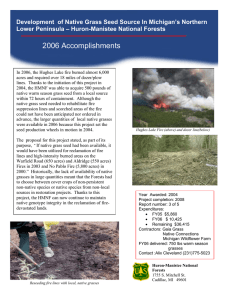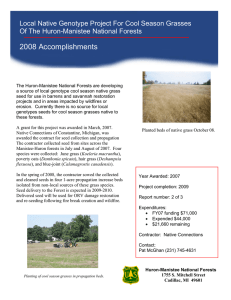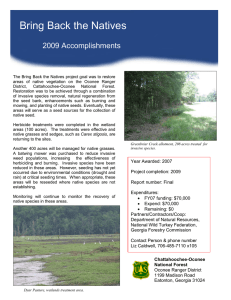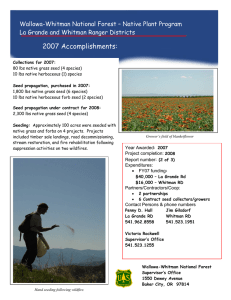Agricultural Field Reclamation Utilizing Native Grass Crop Production J. Curé
advertisement
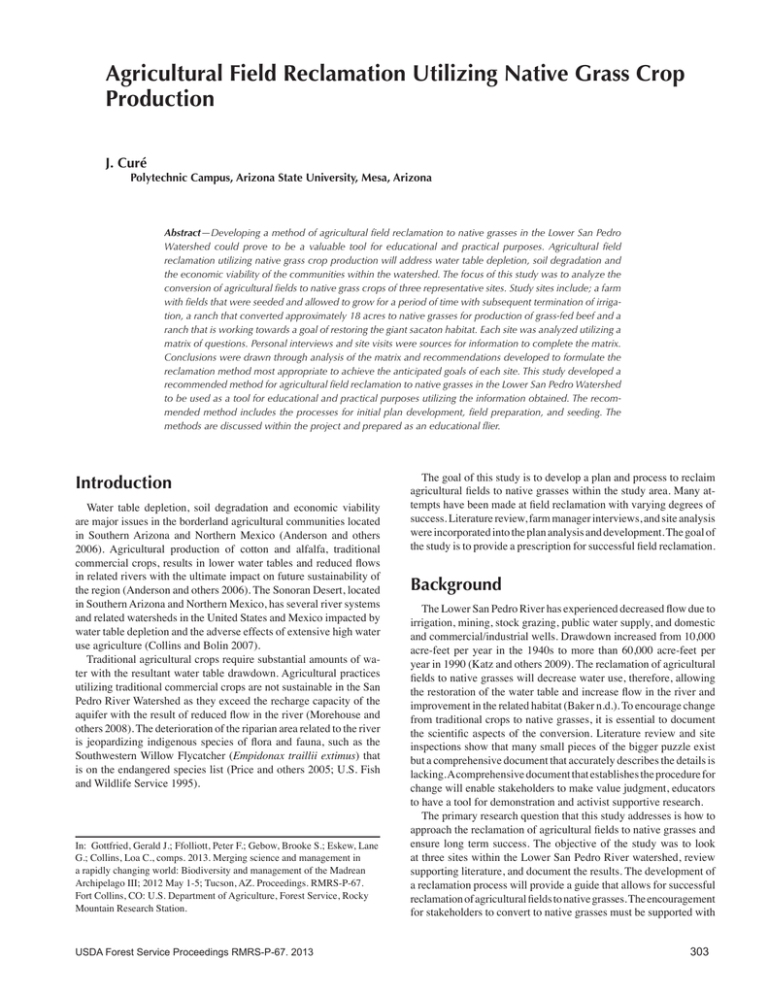
Agricultural Field Reclamation Utilizing Native Grass Crop Production J. Curé Polytechnic Campus, Arizona State University, Mesa, Arizona Abstract—Developing a method of agricultural field reclamation to native grasses in the Lower San Pedro Watershed could prove to be a valuable tool for educational and practical purposes. Agricultural field reclamation utilizing native grass crop production will address water table depletion, soil degradation and the economic viability of the communities within the watershed. The focus of this study was to analyze the conversion of agricultural fields to native grass crops of three representative sites. Study sites include; a farm with fields that were seeded and allowed to grow for a period of time with subsequent termination of irrigation, a ranch that converted approximately 18 acres to native grasses for production of grass-fed beef and a ranch that is working towards a goal of restoring the giant sacaton habitat. Each site was analyzed utilizing a matrix of questions. Personal interviews and site visits were sources for information to complete the matrix. Conclusions were drawn through analysis of the matrix and recommendations developed to formulate the reclamation method most appropriate to achieve the anticipated goals of each site. This study developed a recommended method for agricultural field reclamation to native grasses in the Lower San Pedro Watershed to be used as a tool for educational and practical purposes utilizing the information obtained. The recommended method includes the processes for initial plan development, field preparation, and seeding. The methods are discussed within the project and prepared as an educational flier. Introduction Water table depletion, soil degradation and economic viability are major issues in the borderland agricultural communities located in Southern Arizona and Northern Mexico (Anderson and others 2006). Agricultural production of cotton and alfalfa, traditional commercial crops, results in lower water tables and reduced flows in related rivers with the ultimate impact on future sustainability of the region (Anderson and others 2006). The Sonoran Desert, located in Southern Arizona and Northern Mexico, has several river systems and related watersheds in the United States and Mexico impacted by water table depletion and the adverse effects of extensive high water use agriculture (Collins and Bolin 2007). Traditional agricultural crops require substantial amounts of water with the resultant water table drawdown. Agricultural practices utilizing traditional commercial crops are not sustainable in the San Pedro River Watershed as they exceed the recharge capacity of the aquifer with the result of reduced flow in the river (Morehouse and others 2008). The deterioration of the riparian area related to the river is jeopardizing indigenous species of flora and fauna, such as the Southwestern Willow Flycatcher (Empidonax traillii extimus) that is on the endangered species list (Price and others 2005; U.S. Fish and Wildlife Service 1995). In: Gottfried, Gerald J.; Ffolliott, Peter F.; Gebow, Brooke S.; Eskew, Lane G.; Collins, Loa C., comps. 2013. Merging science and management in a rapidly changing world: Biodiversity and management of the Madrean Archipelago III; 2012 May 1-5; Tucson, AZ. Proceedings. RMRS-P-67. Fort Collins, CO: U.S. Department of Agriculture, Forest Service, Rocky Mountain Research Station. USDA Forest Service Proceedings RMRS-P-67. 2013 The goal of this study is to develop a plan and process to reclaim agricultural fields to native grasses within the study area. Many attempts have been made at field reclamation with varying degrees of success. Literature review, farm manager interviews, and site analysis were incorporated into the plan analysis and development. The goal of the study is to provide a prescription for successful field reclamation. Background The Lower San Pedro River has experienced decreased flow due to irrigation, mining, stock grazing, public water supply, and domestic and commercial/industrial wells. Drawdown increased from 10,000 acre-feet per year in the 1940s to more than 60,000 acre-feet per year in 1990 (Katz and others 2009). The reclamation of agricultural fields to native grasses will decrease water use, therefore, allowing the restoration of the water table and increase flow in the river and improvement in the related habitat (Baker n.d.). To encourage change from traditional crops to native grasses, it is essential to document the scientific aspects of the conversion. Literature review and site inspections show that many small pieces of the bigger puzzle exist but a comprehensive document that accurately describes the details is lacking. A comprehensive document that establishes the procedure for change will enable stakeholders to make value judgment, educators to have a tool for demonstration and activist supportive research. The primary research question that this study addresses is how to approach the reclamation of agricultural fields to native grasses and ensure long term success. The objective of the study was to look at three sites within the Lower San Pedro River watershed, review supporting literature, and document the results. The development of a reclamation process will provide a guide that allows for successful reclamation of agricultural fields to native grasses. The encouragement for stakeholders to convert to native grasses must be supported with 303 Curé Agricultural Field Reclamation Utilizing Native Grass Crop Production evidence that it is an economically viable process for the present and the future. The initial fact finding started with a visit to the Natural Resources Conservation Service (NRCS) office in Tucson and an interview with Ms. Kristen Egen, District Conservationist, in November of 2010. Ms. Egen provided the standard procedure available from the NRCS for the process of planting native grasses in the region. The process includes research involving historic vegetation and soil analysis utilizing the U.S. Department of Agriculture (USDA) NRCS Soil Survey website. The preceding information allows determination of the historical grasses in the area and, with that, a selection for the development of the seed mix to be used. The NRCS website (http:// websoilsurvey.nrcs.usda.gov) is an important resource in the process of field conversion with information about soil type and recommended grasses for the area under question. Study Sites Three representative sites within the San Pedro Watershed were selected for the study: Black Farm Preserve (BFP) owned by the Salt River Project (SRP), Camp Stool Ranch (CSR) owned by the Mercer Family, and Cobra Ranch (CR) owned by The Nature Conservancy (TNC). These sites were chosen on the basis of known qualities including available data, access to the site, and available information and they represent a cross section of sites within the watershed. Interviews and site visits along with written documentation of events on the sites compose the majority of information documented for the results analysis (table 1). Black Farm Preserve (BFP) is owned by the Salt River Project and managed by The Nature Conservancy. The fields planted to native grasses totaled 101 acres. Ruth Valencia, Senior Environmental Scientist for SRP, provided information concerning BFP and the methods used for conversion to native grasses and the subsequent results. SRP worked with the Tucson Plant Materials Center staff for development of the seed mix to be utilized at the BFP. Interviews with Dan Wolgast, the farm manager at BFP, and Molly Hanson with TNC Lower San Pedro River Program provided additional information concerning the process of conversion at BFP and subsequent results. Camp Stool Ranch (CSR), which is owned and operated by the Mercer Family, is an operating cattle ranch. The field area planted to native grasses totaled 18.7 acres. The information on this ranch was obtained from interviews with Mike Mercer and Kristen Egen along with documentation from the NRCS. Several site visits were made to view the fields in the fall and spring. Dan Walgast and Molly Hanson provided additional information concerning the grasses used and history of the site through interview questioning at the site. Cobra Ranch (CR) is a Nature Conservancy property and part of the Aravaipa Canyon Preserve located at the headwaters of Aravaipa Creek, part of the Lower San Pedro Watershed. The initial native grass plantings encompassed 20 acres. Mark Haberstich, the preserve manager, provided excellent historical documentation of the efforts in restoring native grass to the major agricultural fields at the ranch. Table 2 presents information on the scope of reclamation effort at each site. The key questions presented for each of the sites are listed in table 3. The people interviewed were able to provide information to answer the questions and are provided in the “Results” section. The information that was provided is of significant value with application to this study, the results and recommendations for further research. Results Q: What were the existing conditions prior to change from agricultural fields to native grass species? A: The existing conditions for the three study locations varied from current agriculture crops, including cotton, Sudan grass, and wheat, to fallow for several years. BFP fields in the previous years were under a rotation of wheat and cotton. CSR had been growing Sudan grass and winter rye the prior season. CR fields were fallow the preceding 5 years with Sudan grass as the crop in the year 2002. Table 1—Restoration sites, lower San Pedro watershed. Site-Agency 304 Contact Address Phone and email Black Farm Preserve Ruth Valencia Senior Environmental Scientist Mail Station PAB352 PO Box 52025 Phoenix, AZ 850722025 (602) 236-2830 Ruth.Valencia@srpnet.com Camp Stool Ranch Mike and Lori Mercer Owners Mike and Lori Mercer Box 157 Mammoth, AZ 85618 (5200 487-2021 mercer2021@msn.com Cobra Ranch Mark Haberstich Arivaipa Canyon Preserve Manager Preserve 41099 W. Aravaipa Canyon Rd. Klondyke, AZ 85643 (928) 828-3443 mhaberstich@tnc.org The Nature Conservancy Molly Hanson Lower San Padro River Program 1510 E. Fort Lowell Rd., Tucson, AZ 85710 (520) 357-6076 mhanson@tnc.org The Nature Conservancy Dan Wolgast Preserve Manager 80444 E. Pelayo Rd. Winkleman, AZ 85192 (520) 237-6064 dwolgast@tnc.org The Nature Gita Bodner, PhD Conservancy Conservation Ecologist 1510 E. Fort Lowell Rd., Tucson, AZ 85710 (520) 622-3861 gbodner@tnc.org NRCS USDA 3241 N. Romero Rd. Tucson, AZ 85705 (520) 292-2999 Kristen.egen@az.usda.gov Kristen Egen District Conservationist USDA Forest Service Proceedings RMRS-P-67. 2013 Agricultural Field Reclamation Utilizing Native Grass Crop Production Curé Table 2—Scope of site reclamation. BFPCSR CR Date of initial reclamation Approximate acreage initially involved Approximate total acreage available for reclamation 2004 33 101 2008 18.5 18.5 2007 20 50 Table 3—Analysis matrix. BFPCSR CR 1. What were the existing Rotation of wheat and Sudan grass and winter conditions prior to cotton-prior season rye-prior season change over from agricultureal fields to native grasses? Sudan grass-2002-fallow for 5 years prior to planting 2. What was the process Disc harrowed, furrowed, Disc harrowed used for preparing the pre-irrigated fields? Disc harrowed leveled with field cultivator and dragged 3. Was soil weed seed load addressed prior to seeding? Yes, irrigated to stimulate germination and then mowed once Yes, pretreated with No herbicides (pre or ost emergent unknown) 4. What were the seeding Mechanical broadcast Drill seeder, hand techniques? broadcast Drill, mechanical broadcast and hand broadcast 5. Was plugging used for Sacaton? No Yes Yes 6. What was the seed mix used? See detail listing See detail listing See detail listing 7. How successful was germination? Varied with seed type, soil conditions, time of year applied and available water Varied with seed type, soil conditions, time of year applied and available water Varried with seed type, soil conditions, time of year applied and available water 8. What was the follow- up for watering and field maintenance? Irrigation provided until Consistent application to server and transfer maximize production complete Sporadic to maintain cover and minimal growth 9. What is the current Weed populations with condition of the fields? an abundance of native grasses Abundant grasses that provide substantial forage and 62-1 ton bales of hay/17.8 acres Native grass populations increasing providing hay 10. What are the water Total server and transfer savings? Aproximate 50% reduction Undocumented use, greater infiltration rate 11. Is graass-fed beef produced? Yes No No Q: What was the process used for preparing the fields? A: All three sites used disc harrowing as part of the process used for preparing the fields for seeding native grasses. In addition, the first step in the process at BFP was to plow under the fields upon purchase of the property and then furrows were established for irrigation. CSR disced the field areas to be seeded. No other treatment accompanied the initial seeding. Later, wood chip mulch was added to try and improve the organic material content of the soils. CR disc harrowed, leveled, and dragged the fields. Seed drilling without disc harrowing was a followup method at CSR and seed drilling with imprinting was a follow-up method at CR. The addition of soil amendments including manure at USDA Forest Service Proceedings RMRS-P-67. 2013 CSR and CR, wood chips at CSR, and beneficial mycorrhizal fungi at CR was a part of the preparation process for subsequent seed applications. The 2012 planting at CR will use a riphook and plow to prep the field. The theory behind this method is that it will disturb the gophers and allow the plants to grow enough to keep ahead of the gopher population and subsequent destruction of the plant root system. Q: Was soil weed seed load addressed prior to seeding? A: Soil seed load is one of the major problems inherent with the reclamation project, substantiated by literature review, and field interviews with the stakeholders. BFP pretreated with the use of herbicides 305 Curé Agricultural Field Reclamation Utilizing Native Grass Crop Production for broadleaf weeds prior to seeding. It is unknown at the time of writing the results if the pretreatment was a pre- or post-emergent herbicide. CR plowed, irrigated, and mowed prior to initial seeding of native grasses. The field at CSR had been under cultivation without an excessive weed seed load, and, therefore, the native grasses were seeded without treatment for a weed seed load prior to seeding. CSR and CR mowed to control weeds but did not use application of chemicals to control weed seeds. The three sites continue to use mowing as a method of weed control. Timely mowing is critical for success. The weeds must be allowed to mature to the point that flowers are forming or have formed, but seed has not yet set. Q: What were the seeding techniques utilized? A: The seeding techniques varied among the sites. BFP used a mechanical broadcaster initially but ran into problems with the seed clogging the equipment. The range drill proved to be the most effective for the majority of the seeding process. CSR and CR used a combination of drill seeder, mechanical broadcaster, and hand broadcasting. The native seeds vary in shape and size leading to difficulty with distribution mechanically by drill or broadcast. Close attention to the calibration and distribution of the seed is essential for good coverage and subsequent success of the crop. The range drill proved to be the preferred method of application with ease of use and successful distribution of seed for the larger seeds at all three sites. When the practitioners were questioned on the use of hydroseeding, they indicated that the process was too expensive to utilize although labor and project success were not factors in the expense calculations; only the initial rental cost of the equipment was considered. Q: Was plugging used for Sacaton? A: Plugging was not used at BFP but was used to establish Sacaton with later plantings at the CSR and CR sites. Q: What was the native seed mix used? A: The native seed mix varied with each site. NRCS used soil and historic vegetation analysis to help develop the seed list for each site. The actual seed mix varied due to the historic vegetation, soils, seed collection sources, available supply of seed from supplier, provence of the seed source, and the individual budgets for seed purchase. BFP and CSR have similar soils (sandy bottoms) while CR soils have higher clay content. Granite Seed in Utah was the source for the BFP seed supply. Wildlands Restoration in Tucson, Arizona, supplied the seed for CSR and CR (refer to table 4 for listings of plant species). Q: How successful was germination? A: The results from the three sites indicate that germination success depends on a number of variables. The variables include, but are not limited to, the preexisting field conditions, field preparation, soil conditions, soil moisture content, natural rainfall, availability of supplemental water, time of year of seeding, methods of seeding, and provence of seed and seed quality. The climatic conditions were similar for BFP and CSR as they are located west of the Galiuro Mountain Range within the Lower San Pedro River Valley several miles apart near Mammoth, Arizona. CR is in Aravaipa Canyon east of the Galiuro Mountain Range and experiences different climatic conditions. The average yearly rainfall for CSR and CR is 8 inches (http://www.clrsearch.com/Mammoth_Demographics/AZ/Weather- Table 4—Native seed mix. Botanical Name Hilaria jamesii Setaria macrostachya Sporobolus airoides Atriplex canescens Aristida sps. Boutelous curtipendula Sporobolus crytandra Botanical Name 306 Black Farm Preserve (BFP) Common Name Galleta Bristle Grass Alkali-Sacaton Four Wing Salt-Bush Three-Awn Sideoats Grama Sand Drop Seed Camp Stool Ranch (CSR) Common Name Trichachne californica Eragrostis intermedia Setaria macrostachya Bouteloua barbata Bouteloua curtipendula Bouteloua gracilis Botriochloa barbinodis Leptochloa dubia Setaria macrostachya Sporobolus wrightii Arizona Cottontop Plains Lovegrass Large-spike bristlegrass Sixweeks Grama Sideoats Grama Blue Grama Cane Bluestem Green Sprangletop Bristle Grass Wright’s Drop Seed Botanical Name Cobra Ranch (CR) Common Name Andropogon barbinoides Bouteloua gracilis Bouteloua rothrockii Festuca microstachys Leptochloa dubia Plantago insularis Schizachyrium scoparium Setara macrotachys Sporobolus crytandra Cane Beardgrass Blue Grama Rothrock Grama Small Flowered Fescue Green Sprangletop Indian Wheat Little Bluestem Plains Bristlegrass Sand Drop Seed Application Rate 0.8# per acre 1# per acre 1# per acre 1# per acre .5# per acre 6# per acre unknown Application Rate Mix @ 15# per acre Application Rate Mix @ 20# per acre USDA Forest Service Proceedings RMRS-P-67. 2013 Agricultural Field Reclamation Utilizing Native Grass Crop Production Forecast-Temperature-Precipitation?mammoth,az) while CR yearly rainfall average is 15 inches (USDI BLM 2010). Rainfall affects the ambient soil temperature and the soil moisture content, both of which influence seed germination. Although the three sites had variations with germination success it would appear that CR had inherently fewer challenges due to more favorable climatic conditions. The field conditions of BFP and CSR were similar in that they had been cultivated within the past year even though the crops at each site were different. CR had not been cultivated for a number of years and the soils were compacted and contained a substantial weed seed load. The soil at CR required tilling and irrigating for a season to reduce the weed seed load and create a more favorable seed bed. The seed source for BFP was Granite Seed in Utah. The seed supplied was harvested in Utah and, therefore, did not have the same genetic characteristics as the seed provided by Wildland Seed harvested in the Tucson area for CSR and CR. The genetic variation will have an effect on the long term success of the native grasses. This is evident with the necessity for BFP to reseed in subsequent years as a result of poor germination and seedling survival. Q: What was the follow-up for watering and maintaining the fields? A: BFP irrigated the fields for the first 3 years before sever and transfer of the water rights took place. The purpose for the conversion of the agricultural fields to native grasses at BFP was to transfer the water back to the river, the legal return of the water, and the water rights back to the river. The weed problem is a continuing issue and control with mowing on an as-needed basis is the method utilized. CSR provides irrigation on a regular basis with an established schedule. A center pivot system that provides water to the fields is turned on and off manually. Weed control is performed by mowing at the appropriate times to prevent seed formation. CR provides irrigation on an as-needed basis determined by soil moisture content and plant health. The fields were flood irrigated initially but recent installation of a wheel line system has allowed for changeover of some of the fields. Weed control was performed by mowing at the appropriate time and some hand weeding in select areas. The fields with native grasses will not need to be completely re-seeded in 3 to 5 years as do alfalfa fields or every year as with cotton. Q: What is the current condition of the fields? A: The BFP has weed populations with an abundance of native grasses although many species of native grasses are declining. CSR has weed populations with abundant grasses that provide substantial forage and hay. The native grass populations are increasing and competing with the weed population. Sixty-two 1-ton bales of native grass hay were harvested in the year 2010 from the 17.8 acres as opposed to the 45 bales of Sudan sorgum from the same area in previous years. The rancher indicates the cattle grazing on the native grasses are healthier, weigh more at the sale and produce better quality meat. CR has sporadic weed populations with native grass populations increasing providing hay for livestock and erosion control within the geographic area. Water infiltration of the soil has increased. Q: What are the water savings? A: Water savings at BFP were 100% as all the irrigation wells were turned off and the water allowed to flow to the river. The water savings at CSR is estimated at 50% calculated from the amount of time the pump runs compared to previous years with the high water-use crops on the fields. CR water use is not well documented. The water use on the fields to produce the previous crops was not recorded. A piezometer was installed in 2009 on the creek; prior to that no records of water use or impact on the river were maintained. Q: Is grass-fed beef produced? USDA Forest Service Proceedings RMRS-P-67. 2013 Curé A: BFP and CR do not produce grass-fed beef for market. CSR is producing grass-fed beef and markets it at the local farmers market and other related outlets. The current market price for grass-fed beef is $6.50 per pound (Cunningham 2012) as opposed to the price for grain finished or alfalfa-fed beef at $3.87 per pound (Kavilanz 2012). Conclusions Analysis of field conditions prior to the onset of reclamation is critical to the approach taken for reclamation. Factors to be looked at and included in the plan are the type of soil, historic vegetation, weed seed load, existing or potential for irrigation, budget for the project and goal for the crop to be produced. The plan for reclamation can be formulated based on the previously mentioned factors and the goals for the project. Consulting with the NRCS will assist in the development of a comprehensive plan. Careful attention to soil preparation, seeding methods, and continued care are essential for crop success. Documentation from Cobra Ranch indicates the areas with the highest success in establishing native grasses (i.e., germination and health of seedlings) were the sites in which weed seed load was reduced prior to planting, soils were prepared with nutrients, and additions were made as necessary. The method of seeding was based on the type of seed. Seeding occurred when appropriate seasonal parameters were met, supplemental irrigation was applied as needed, and weed control was performed as needed. Provenance of seed appears to have contributed to success. The seeded species appear to have established at higher frequency in fields planted with local seed compared with seed originating in Utah. Camp Stool Ranch demonstrated that use of native grasses reduced water use (translated to energy use) and labor and the ongoing investment to maintain crops on the fields. The market for grass-fed beef is strong and supports the premise for developing native grass crops. The average retail price of ground beef is $3.87 (Kavilanz 2011), while the market price for one pound of organic grass fed beef is $6.50 (Cunningham 2012). CR has generated hay to use as mulch for restoration purposes or as feed for cattle that are foraging in large pastures where seed can be spread. The hay is valuable in more than dollars and cents as it provides a seed source that contains the gene pool indigenous to the area, an important factor for restoration projects. The neighbors are inquiring for hay for their livestock as well. Analysis of the BFP fields indicates that it is possible to seed fields and provide irrigation for a limited time with some success in crop establishment. However, the long term success without supplemental irrigation is totally dependent on weather conditions and rainfall. Each of the analyzed projects had different goals. The goal that SRP had for BFP was to establish native grasses and sever and transfer the water back to the river. The CSR goal is to establish a viable commercial agricultural crop. The crop in this case is grass-fed beef that they are now able to provide with the forage and hay produced by the native grass fields. The CR goal is to develop a seed bank, provide forage crops, and initiate a soil improvement program while working towards the ultimate goal of restoration of the giant sacaton habitat. Each of the goals for the separate projects has been demonstrated as being achievable. The key to success for the projects points to the attention to detail and following the prescribed plan. The natural monsoonal patterns play a key role in the establishment of the grass crops. Additional irrigation is essential if the monsoon is not an active season delivering adequate rainfall. Long-term water needs for the crops will not be as great as the initial seeding and establishment period. Water must be available on a regular basis to have a successful germination and establishment of plants. Field 307 Curé Agricultural Field Reclamation Utilizing Native Grass Crop Production reclamation to native grasses is a viable option for an agricultural enterprise and holds multiple opportunities for the development of a sustainable agricultural environment ensuring resiliency to the changing climatic patterns through resource conservation. Resource conservation was demonstrated by the three sites with the reduction of water use and the reduction of extensive applications of fertilizers high in nitrogen required by alfalfa and cotton crops. Recommendations Recommendations are presented below for future research, analysis, and educational action. 1. Perform market-value studies for native grasses as forage, hay, seed banks, and restoration projects to substantiate the benefits of the native grass crop. 2. Develop the economic information to substantiate native grasses as a compelling agricultural crop. 3. Analyze the nutrient value of native grass hay compared to alfalfa to be used as a marketing and educational tool. 4. Determine per ton cost of native grass hay compared with alfalfa (yield analysis) to assist with education about native grass farming. 5. Educate the public about the importance of utilizing native grasses as a crop (figs. 1,2). 6. Extend a comparative analysis over a number of years by quantifying (1) labor for planting and care, (2) seed cost for the perennial crop versus annual or short-term crops, (3) fuel costs for preparing, planting, and field maintenance, and (4) nutrient and supplement needs (particularly nitrogen/urea application) of native grass versus other crops. References Anderson, G., Dick, E., Minor, J., and Prichard, A. 2006. Rethinking water in the arid Southwest: The need for a new framework for managing water in Arizona. Arizona’s Comprehensive Wildlife Conservation Strategy: 2005-2015. Arizona Game and Fish Department. 2 pp. Baker, D. (n.d.) Bingham Cienega Natural Preserve The Nature Conservancy Restoration Project. Saguaro Juniper Cooperation. Online: http://www. saguaro-juniper.com/i_and_i/san_pedro/bingham_cienega.html. [March 10, 2012]. Bodner, Gita (personal communication, June 29, 2011, October 12, 2011). Cunningham, J. 2012. Grass-fed beef. Coyote Creek Farm website: ttp:// coyotecreekfarm.org/beef/ [April 18, 2012]. Figure 1—Sample brochure. 308 USDA Forest Service Proceedings RMRS-P-67. 2013 Agricultural Field Reclamation Utilizing Native Grass Crop Production Curé Figure 2—Sample restoration methodology. Collins, T., Bolin, B. 2007. Characterizing vulnerability to water scarcity: The case of a groundwater-dependent, rapidly urbanizing region. Environmental Hazards 7: 399–418. Egen, Kristen (personal communication, November 23, 2010). Haberstich, Mark (personal communication, December 8, 2011, January 5, 2012). Hanson, Molly (personal communication, November 23, 2010, June 9, 2011, June 29, 2011, October 12, 2011). Katz, G., Haney J., Paradzick C., and Harris D. 2009. Mitigation, Restoration and Endangered Species. In J.Stromberg, and B. Tellman (eds.). Ecology and Conservation of the San Pedro River. Tucson, AZ: The University of Arizona Press: 345-370. Kavilanz, P. 2011. Beef prices soar. CNN Money website: http://money. cnn.com/2011/03/31/markets/beef_price_increasing/index.htm. [April 18, 2012]. Mercer, Mike (personal communication, November 23, 2010). Morehouse, B., Ferguson, D., Owen, G., [and others]. 2008. Science and socio-ecological sustainability: Examples from the Arizona-Sonora border. Environmental Science and Policy 11(3): 272-84. Price, J., Galbraith, C., Dixon, M., [and others]. 2005. Potential Impacts of Climate Change on Ecological Resources and Biodiversity in the San Pedro Riparian National Conservation Area, Arizona. A Report to U.S. EPA from the American Bird Conservancy. 543 p. Online: http://cfpub.epa.gov/si/ si_public_record_Report.cfm?dirEntryId=180083&CFID=15505330&C FTOKEN=33891245&jsessionid=20308e19b20a47c456493el26563345 2703b [March 15, 2012]. U.S. Department of the Interior Bureau of Land Management (USDI BLM), 2010. Draft Aravaipa ecosystem management plan and environmental assessment. Online: http://www.blm.gov/pgdata/etc/medialib/blm/az/pdfs/ nepa/library/wilderness_plans/aemp.Par.32179.File.pdf/AravaipaEMP. pdf. [April 18, 2012]. U.S. Fish and Wildlife Service. 1995. Endangered and threatened wildlife and plants: Determining endangered status of the Southwestern Willow Flycatcher. Federal Register: status of the Southwestern Willow Flycatcher. Federal Register: 10694-10715. Online: http://ecos.fws.gov/speciesProfile/ profile/speciesProfile.action?spcode=B094. [April 29, 2012]. Valencia, Ruth (personal communication, December 3, 2010, June 9, 2011). Wolgast, Dan (personal communication, November 23, 2010, October 12, 2011). Wong-Gonzalez, P., Pineda, N., Varady, R. 2008. Science and socio-ecological resilience: Examples from the Arizona-Sonora Border, Environmental Science & Policy 11(3): 272–284. The content of this paper reflects the views of the authors, who are responsible for the facts and accuracy of the information presented herein. USDA Forest Service Proceedings RMRS-P-67. 2013 309
